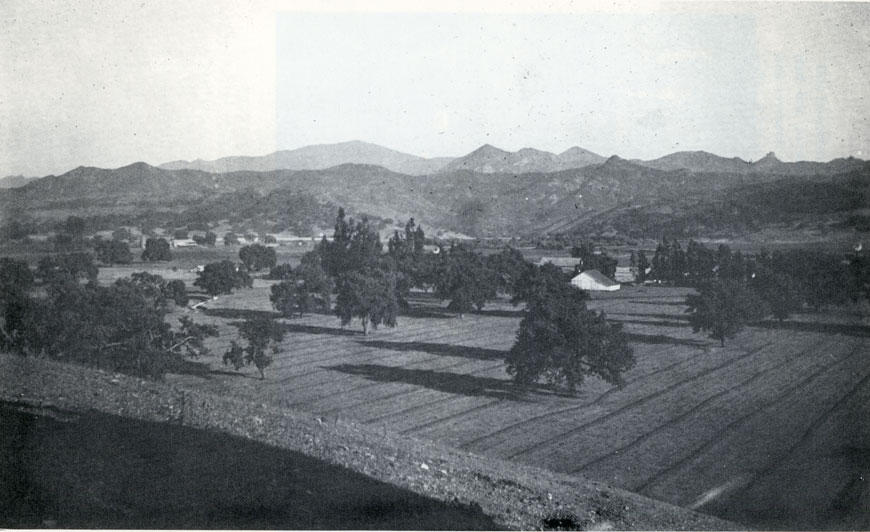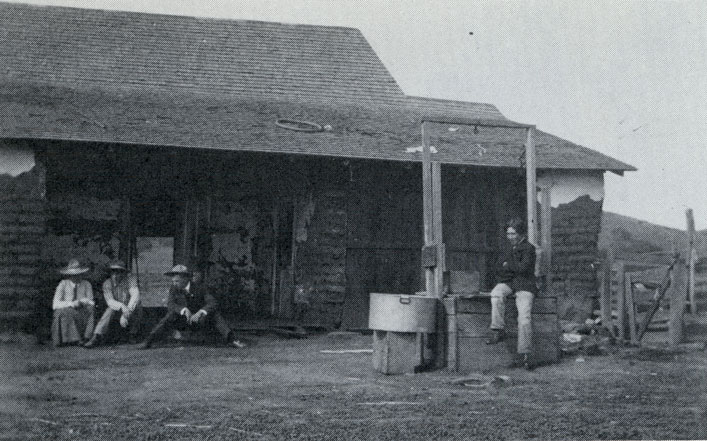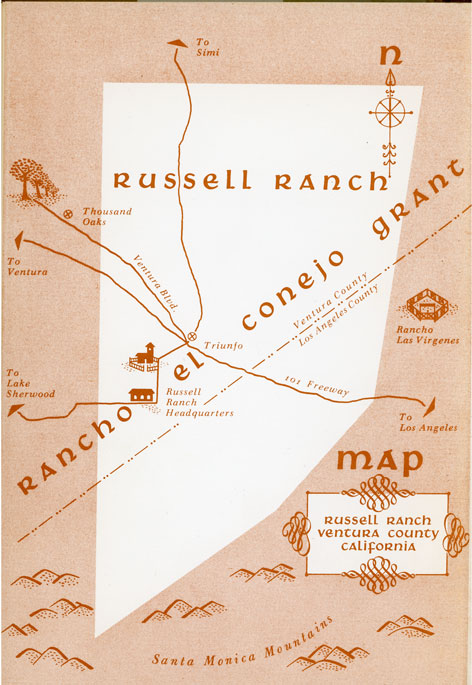By J.H. Russell
In this edition of Journal Flashback, we present a little nugget on a very short-lived gold rush in the Conejo Valley. In this account J.H. Russell shares his memories of gold rumored to be he on his father’s land, as well as continued whispers of buried treasure around an old adobe. The tale of buried gold is a popular story that is attached to many adobes in the region. The Russell family’s ranch is now Westlake Village. For those interested in a history of the ranch see J.H. Russell’s “Cattle on the Conejo” and “Heads and Tails … Odds and Ends” or Patricia Russell Miller’s “Tales of Triunfo”. This article is from one of the first quarterlies, Volume 1, No. 3 (May 1956). Enjoy!

Of course the history of California is replete with various stories of gold rushes and stampedes, not so much in Southern California as in the north; however, the Conejo had a gold rush all of its own. In fact there were two, although one was for buried treasure and was not so much of a rush as a search over a good many years for hidden treasure.
In the days before the automobile, if we saw a rig coming down our way, we could be about sure it was coming to our place—while the road past our place went on into the Potrero, most people came there over another road. My father was very hospitable and anyone coming our way that he got into a conversation with, he generally asked to stay for dinner; never for breakfast as he could not conceive of breakfast after 5:00 A.M.
In the early light he glanced up the road one morning and saw a rig coming and went out to see who was coming and possibly ask him to dinner—but before the rig turned off the road towards our place and had come very far, to his amazement he saw not only one rig turning but what seemed to be dozens of them—carts, buggies, spring wagons, etc. He stood in the road waiting for the procession to reach him. The first man drew up and after greetings said, “We have come to file on gold claims.” This amazed my father still more because he knew nothing about any gold ore in our vicinity. Furthermore, his title for the ranch came from a Mexican grant and these titles granted the mineral rights to the owner. At the extreme east end of our place was a mound which at one time had been an adobe house. A ditch carrying water from the Triunfo Creek ran by there. Also there was an old arrastra1 under a tree nearby. This is what they told him. The Triunfo Canyon was a very pleasant place to camp and many people came there to stay over night or maybe for several weeks. It seems that someone had picked up a rock specimen in the old arrastra and had it assayed and it proved to be wonderfully rich in gold, and they were coming to stake claims before the news spread too far. My father pointed out to them that they could not file without his permission, but some kind of an understanding was reached and they were on their way to what they hoped and probably believed would be their fortunes.
However, nothing in the way of gold was found and the strike fizzled, as many others had before. Many people searched for the mine from which the ore could have come to be ground up by the “raster”, as an arrastra was commonly called. I never saw or heard of anyone who had ever seen the ditch with water in it or knew anything about the old adobe or the old “raster.” Still, it was there and a rich piece of ore was found in it. Stranger still, about thirty years later a local man interested in mineralogy found a rock which assayed very rich in gold.

There must have been ore somewhere near enough to mine and bring in to be crushed and washed. The only means of transportation would have been pack mules or on the backs of Indians. So, who knows maybe Ventura, too, has a lost mine either in the Conejo or possibly Las lngines Grant2
Treasure was supposed to have been buried by the Mexicans before the battle of Triunfo, which was supposedly fought on the banks of Triunfo Creek and near an old adobe ranch house on our ranch. Inasmuch as the Mexicans reportedly won the battle, I could never understand why there would be any treasure in the ground as the Mexicans, if they ever buried any, would have most certainly dug it up. Be that as it may, the search went on from time to time for forty or fifty years. Even as late as sometime in the 1930s, my young son would come in from the sleeping porch and tell me there was a light in the old adobe. I thought it was his imagination as the result of a pretty heavy diet of Westerns; however, one day in riding past the adobe I stopped to take a look and found the fireplace toppled over and a gaping hole where it stood. The plan in the reasoning of whoever did it was that the fireplace was not originally in the building, but had only been built for five or six years.

The old Cutler place, which my father bought, had a house which was used as a stage station and the people who operated it at that time had two small sons. I think this must have been around 1875. One day they noticed that one of these little boys was playing with a coin. They cleaned it and found that it was a Mexican gold coin. While he would tell somewhere near where he found the coin, the only thing definite they could get out of him was that a “squirrel dug it up.” He had found it on top of the dirt from a freshly dug squirrel hole. As squirrels in those days were about as thick as flies, it was impossible to locate the exact spot. About forty years later, the brother came back and said he had with him a man with a divining rod who could locate gold; and if he could search for treasure, he would give us half of what he found. He said he had a general idea of where his brother had as a small child found the Mexican coin. I never did get any buried treasure, but from time to time we would find holes dug in the vicinity of the old adobe, but we never heard of anyone getting the buried treasure.
Editor’s Note3: In the mid-1920s a Spanish silver coin was found in the Briggs region and started a similar buried treasure rumor. At the time of the St. Francis Dam Flood in 1928 considerable soil was washed from the spot and an Indian rancheria site exposed. Later, another Spanish coin was found on the same location. Both were minted around 1812. The inference in this particular case would seem to be that the Indians had come into the possession of the coins honestly, or otherwise, and left them behind at the time they departed from the site.
Make History!
Support The Museum of Ventura County!
Membership
Join the Museum and you, your family, and guests will enjoy all the special benefits that make being a member of the Museum of Ventura County so worthwhile.
Support
Your donation will help support our online initiatives, keep exhibitions open and evolving, protect collections, and support education programs.
- Arrastra is a Spanish word and refers to a type of mill used to process gold or silver ore. The design is a very ancient one and was used throughout the Mediterranean. You’ve very likely seen one in a Western film. For further information and resources see: https://en.wikipedia.org/wiki/Arrastra and https://westernmininghistory.com/1568/the-arrastra-illustrated-in-these-historical-photos/
- The original article reads “Las Ingines grant” but this may be a typo and it would make more sense if it was referring to Rancho Las Virgenes.
- This is a note from the original editor in 1956 and was not added by current staff.
